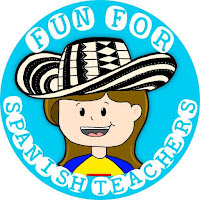
BRINGING CI INTO YOUR ELEMENTARY CLASSROOM
As a CI Spanish Teacher for 4 years now, I have seen firsthand how Comprehensible Input can work wonders to best promote Spanish language acquisition in young learners. This involves using language and repetition at the appropriate proficiency level of students and teaching the language in “context” in a variety situations. It capitalizes on young learners’ innate ability to learn languages and is quite different than the way the majority of today’s adults (parents and fellow educators alike) learned languages. It moves away from thematic units where the vocabulary is disconnected, to instead focus on teaching high frequency vocabulary in context.
INPUT, INPUT, INPUT: COMPREHENSIBLE AND COMPELLING
The idea is to provide enough exposure to the input to help young learners feel safe and comfortable in the target language and ensure the teacher uses the target language at least 90% of the time. The goal is not grammatical perfection or even much focus on explicit analysis or writing. In fact, it’s much more important to focus on building oral proficiency and an ear for the Spanish language as well as empathy for and interest in other cultures (where, for example, it’s vital to counter stereotypes and correct misconceptions).
CI IS FLEXIBLE AND YOU WILL NEVER GET BORED WITH SO MANY STRATEGIES TO CHOOSE FROM
One of the things that I love about being a CI Spanish teacher in an elementary world language program is the flexibility of the curriculum and how dynamic the process of creating it can be. I see a curriculum at the elementary level as something that is constantly evolving in relation to the interests of the students, collaboration with other subjects / teachers, use of technology, and attention to current events. I have been lucky enough to be an active part in the creation of the Spanish curriculum at many schools where I have taught. With CI, I feel that I have been able to use an ever greater variety of teaching tools in my professional practice. This image created by Sra. Dentigler’s blog shows different CI strategies, and has inspired me to create a puzzle showing the ones I’ve used the most with my elementary students.
Click HERE to open the link on every piece of the puzzle.
UNDERSTANDING THE DEVELOPMENTAL STAGES OF YOUR STUDENTS IS IMPORTANT
As an elementary-level teacher, it is also important to understand the different developmental stages of students when planning a curriculum. This is key to learn when to start introducing simple reading and writing skills in the target language and also to plan the kinds of activities needed to support the curriculum. For example, the younger the students are, the more they will need to move! In keeping with the Natural Approach, working on listening skills and allowing space for students to be exposed to a lot of input in the early years will create the foundations for later years. I enjoy being able to inject my own or my team’s creativity in the curriculum. I lately have discovered my love for Story Listening with the younger grades.
FOCUS ON WHAT YOUR STUDENTS CAN DO, NOT ON THE MISTAKES
In practice, I work hard to let my students know that it is okay to make mistakes and that being uncomfortable, vulnerable, even silly is just part of learning a language. My classroom is a safe space to learn by doing, pushing each other out of our comfort zones. I use Spanish without breaking into English approximately 95% of the time. I use gestures and questions to check for understanding. Games and music are teaching instruments that I use a lot in classes.
¡SÍ SE PUEDE! YOU CAN INCORPORATE CULTURE IN YOUR CI CURRICULUM
I am a “culture lover” and enjoy when there is space in the curriculum to share with my students about the cultural diversity of Spanish speaking countries (and yes, I include “La Guinea Ecuatorial”). Of course, being from Colombia means that my students get to learn a little bit more about the Colombian culture (and the great diversity that exists there) than any other Spanish-speaking countries. I use authentic resources and materials in class.
THERE IS ROOM FOR COLLABORATION WITH OTHER TEACHERS
As a specialist (non homeroom) teacher, I feel it is key that the school community works together to provide a rich curriculum and experience for students that is both nurturing and challenging. I work hard to negotiate with and understand the needs and interests of classroom teachers, and I am patient but firm, particularly because this approach to teaching a language requires a fair amount of re-education. See my post on the monarch butterfly migration to learn how I have collaborated with other teachers in the past.
I also recommend Mundo de Pepita’s blog if you are looking to learn more about CI at the elementary level!
Happy CI journey!





